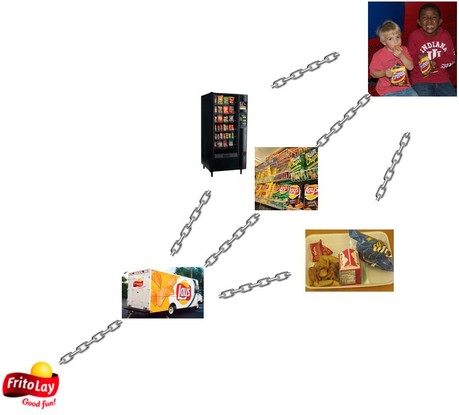Supporting the Demand (Customer) Chain
Start with the End-Customers, but Make Sure You’re Making It Easy for Every Stakeholder Between You and Them
Just as there are multiple links in your supply chain, there are many participating organizations in your demand chain. When you start thinking of the demand chain as a “customer chain,” you can delight all links in that chain down to the end-customer—the one who actually uses your product or service—by understanding the needs and scenarios of every participant along the way.
NETTING IT OUT
No matter what kinds of products or services you offer, the chances are good that you have more than one set of customers. You have end-customers—the people who use or consume the products or services you provide. You also have people who pay for those services—who may or may not be the same people who use them. You may also have many layers of customers and partners who package, deliver, sell, service, and empower your end-customers. Each of these distribution partners and/or customer types form part of a complete demand chain—with many links between your firm or department to your end-customer.
In order to design, nurture, and streamline your customer-centric ecosystem, you’ll need to become clear about, and build consensus about, all the different types of customers in your demand chain. The people at each level have goals to meet and needs to satisfy.
DEMAND CHAIN = CUSTOMER CHAIN
Looking Back to the Supply Chain
Long before the focus on making it easy for customers to achieve their goals, companies understood the needs of their supply chain. Manufacturers knew how early their materials suppliers needed product forecasts to ensure that the right materials were available when they needed them; Distributors knew when manufacturing plants would be at peak performance or closed for vacation. Before the customer revolution, companies focused on making it easy for their suppliers. The goal was a win/win/win for all parties: the more streamlined and accurate the supply chain processes, the lower the costs and time lapses for all. Good supply chain forecasting relied on your organization—which is, in fact, the “customer” to the manufacturers and distributors who serve you—to be well-behaved and organized. I image that the purchasing department staff responsible for making sure the organization had the right materials at the right time at the right price would have loved to have tools from the suppliers to make it all easier. But the onus was, and, in many cases, still is, on the purchasing customer to make sure that the supply-ordering process is efficient and effective.
The Value Chain: Supply Chain Combined with Demand Chain = Customer Chain
When you turn this all upside down and look at purchasing from the demand side, it becomes so clear that this demand chain is, indeed, part of a “customer” chain.
Your organization is typically somewhere in the middle of a value chain, with your suppliers on one side of the chain and your customers on the other. Traditionally, the opposite side of the supply chain is called the demand chain, but we encourage you to think of it as the customer chain—all the people who touch our products and services on their way to being used by the ultimate end-customer.
The Customer Chain Starts with the End- Customer
Your end-customer is the person who uses or consumes the products or services you provide. The end-customer isn’t necessarily the person or company that gives you money. It is important to make things easy for all your customers, but never at the expense of the end-customer. The end-customer is the reason why you, and every link on the chain, up and down, make what you make or offer.
IDENTIFYING THE END-CUSTOMER. Here’s a simple way to identify the end-customer. Think about Frito Lay. The snack company makes potato chips. But it sells its chips to distributors who care about things like how easy it is to transport the snacks. The distributors sell to grocery stores, which care about things like how well do the packages scan at the register. But if the potato chips don’t taste good, no one is going to make any money! The person who eats the potato chips—literally, the consumer—is the end customer. (See Illustration 1.)
The Customer Chain
© 2013 Patricia Seybold Group Inc.
1. Although Frito Lay makes potato chips, the company doesn’t really touch the end-customer who eats the chips. In this customer chain, Frito Lay’s direct customers are the distributors who ship the chips to the sales outlets. These retailers are the ones who actually sell the product to the consumers. If there are snags any- where in the customer chain (e.g., late delivery, inability to properly place the items on the shelves, or even back at the beginning where some potato chips don’t get, say, enough salt), the end-customer will be unsuccessful in his desired outcome of fresh, tasty, salty goodness. And stale, tasteless, hard to find (on shelves) chips will lose customers’ business and impact every link in the customer chain. Note, too, that the customer chain may include multiple customers at similar positions on the chain (e.g., the vending machine company, the supermarket, and the deli lunch counter).
At each step in the customer chain, there are people who deal with the merchandise. Each role has things that she wants and needs to make it easy to do her job—these are her conditions of satisfaction.
Table A shows the needs and conditions of satisfaction for the people at each link in this customer chain. Note that satisfying the customer in each position doesn’t necessarily always fall on the shoulders of the previous link in the chain. Sometimes you jump back a few links to the manufacturer or even earlier in the vendor’s supply chain.
(Download the PDF for the entire article, including the table.)
Sign in to download the full article
0 comments
Be the first one to comment.




